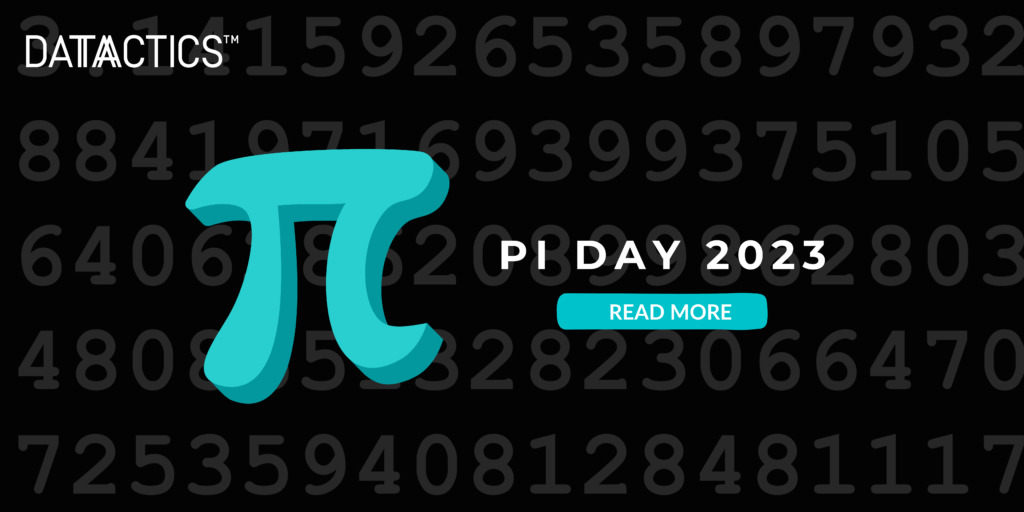
Every math enthusiast’s favorite day of the year has arrived – Pi day. Celebrated on 14th March every year, it represents the first 3 digits of Pi – 3.14 (in the American date format). As it happens, it is also the same date as Albert Einstein’s birthday!
Senior Software Developer, Edele Copeland, explains why she loves Pi and shares a few ways to celebrate Pi Day 2023, including how to find your birthday in Pi .
What is Pi?
Represented by the Greek letter, π, most people would have come across this magical number in secondary school, where it would have been taught as part of calculating the area of a circle or the volume of a sphere. At school, Pi was just a large, irrational number that existed; a symbol on your calculator that can be represented by the number 3.14. But there is an actual meaning behind where it originates from.
If you were to draw a perfect circle using a compass, you could place a string on top of the circle, going around exactly once. When straightening out the string, the length would represent the circumference of the circle (hopefully some GCSE Maths knowledge is coming back?), which can then be measured using a ruler.
Next, you would measure the diameter of the circle (i.e. any line that goes through the center of the circle – where the compass would have been placed – from one point on the circle to an opposite end). Using these two measurements, if you divide the circumference by the diameter, you would get an answer around 3.141592653589793238… or π. This will always be the case, no matter how big or small you draw the circle.
Where is it used?
Most commonly, Pi is used in calculations involving circles, spheres, and ellipses – this is what most people would have learned in school. But it also has essential use in trigonometry, defining infinite series, and Calculus.
Pi is used in real-world applications every day. To name a few, it is used to track statistical data like population dynamics, in GPS navigation, and in biochemistry to understand DNA structures. It can also be used to test how powerful a computer is, as the calculation of Pi can determine how accurately the computer’s hardware and software are working and whether changes need to be made.
Why do I celebrate Pi day?
At school, maths was something I really enjoyed. I liked that there are so many real-world applications of maths, and applying logical thinking to work out a problem was what I was good at (unlike writing an essay, maths had one right answer, and there was no subjectiveness about it!).
Whilst studying for my A-Levels, I decided to do maths and further maths. One teacher, in particular, was a great influence on how my passion for maths grew, encouraging me to continue the subject into university.
During my four-year university course, I studied a mix of Pure, Statistical Maths, and Applied Maths. Within these 3 areas, Pi was always creeping into formulas, whether it was part of Number Theory, Classical or Fluid mechanics, or modeling within biology and medicine. It was used everywhere during my studies and in real life. Even during my final year, I was constantly using Pi within formulas and computations to analyze and prove my dissertation hypothesis.
Pi remains an important constant within maths and deserves recognition in the form of its own day!
Fun facts to help you celebrate Pi Day 2023
- Physicist Larry Shaw started celebrating March 14th as Pi day at San Francisco’s Exploratorium science museum. There he is known as the Prince of Pi.
- It’s actually part of Egyptian mythology – people believe the Pyramids of Giza were built on the principles of Pi.
- Pi was used in the famous O.J. Simpson trial, where an FBI agent’s findings in the case were discarded due to his wrongful use of Pi.
- The Greek letter π is the first letter of the word periphery and perimeter. Pi is the ratio of a circle’s “periphery” (i.e. its circumference) to its diameter.
- Even today, people are still trying to calculate more digits of Pi. In 2010, a Japanese engineer and an American computer wizard broke the record for the most number of Pi digits by calculating up to 5 trillion digits of Pi.
There are lots of ways to get involved with Pi Day, including testing yourself with this Pi Quiz and, of course, finding your birthday in Pi using this calculator– mine lies at position 46,377.
Happy Pi Day everyone!

Edele Copeland is a Senior Software Developer at Datactics. For more insights from Datactics, find us on Linkedin, Twitter or Facebook.